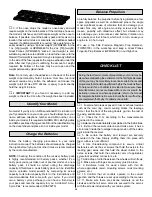
7. I will not fly my model unless it is identified with my name
and address or AMA number, on or in the model.
9. I will not operate models with pyrotechnics (any device
that explodes, burns, or propels a projectile of any kind).
1. I will have completed a successful radio equipment ground
check before the first flight of a new or repaired model.
2. I will not fly my model aircraft in the presence of
spectators until I become a qualified flier, unless assisted by
an experienced helper.
3. I will perform my initial turn after takeoff away from the pit
or spectator areas and I will not thereafter fly over pit or
spectator areas, unless beyond my control.
4. I will operate my model using only radio control frequencies
currently allowed by the Federal Communications Commission.
End of AMA Safety Code
The Ryan STA-M is a great flying sport airplane that flies
smoothly and predictably, yet does not have the self-recovery
characteristics of a primary trainer. Therefore, you must either
have mastered the basics of R/C flying or seek the assistance
of a competent R/C pilot to help you with your first flights.
Note: Fully cowled engines may run at higher temperatures
than an un-cowled engines. For this reason, the fuel mixture
should be richened so the engine runs at about 200 rpm
below peak. By running the engine slightly rich, you will help
prevent dead stick landings caused by overheating.
If not yet confident in your flight skills with a low-wing model,
have an experienced modeler standing by (or at the
controls) who can provide assistance or take over if
necessary. Tell him to remind you to throttle back once the
plane gets to a comfortable altitude. While full throttle may
be desirable for takeoff, throttling back a bit once in the air
isn't a bad idea to make things happen slower, giving you
more time to react.
Before taking off, see how the model handles on the ground by
doing a few practice runs at low speeds on the runway. Hold
“up” elevator to push the tail down and keep the tail wheel on
the ground. If the rudder is centered but the model does not roll
straight down the runway, adjust the tail wheel steering by
turning the nylon ball link on the end of the tail gear pushrod in
or out. After making ground handling adjustments and getting
used to how the model handles, return to the pits, shut off the
engine and top off the fuel. Check all fasteners and control
linkages to be certain they are secure.
When ready, place the model on the runway facing into the wind.
Hold a bit of up elevator to keep the tail on the ground to
maintain tail wheel steering, then gradually advance the
throttle. As the model gains speed decrease up elevator,
allowing the tail to come off the ground. Be ready to apply right
rudder to counteract engine torque. Gain as much speed as the
runway and flying site will practically allow before applying up
elevator and lifting the model into the air. Be smooth on the
elevator stick, allowing the model to establish a gentle climb to
a safe altitude before turning into the traffic pattern established
at the field you are using. It should be noted that the prototype
Ryan STA-M powered by an O.S. MAX .91 FS usually required
only about 3/4 throttle for takeoff. If flown in a smooth, scale-like
manner, full power may not always be required–even on takeoff!
Take it easy with the Ryan for the first few flights, gradually
getting acquainted with it as you gain confidence. Adjust the
trims to maintain straight and level flight. After flying around for
a while and while still at a safe altitude with plenty of fuel,
practice slow flight and execute practice landing approaches by
reducing the throttle to see how the model handles at slower
speeds. Add power to see how it climbs as well. Continue to fly
around, executing various maneuvers and making mental
notes (or having your assistant write them down) of what trim
or C.G. changes may be required to fine tune the model so it
flies the way you like. Mind the fuel level, but use this first flight
to become familiar with the Ryan model before landing.
Flight
Takeoff
CAUTION (THIS APPLIES TO ALL R/C AIRPLANES): If,
while flying, you notice an alarming or unusual sound such as
a low-pitched “buzz,” this may indicate control surface flutter.
Flutter occurs when a control surface (such as an aileron or
elevator) or a flying surface (such as a wing or stab) rapidly
vibrates up and down (thus causing the noise). In extreme
cases, if not detected immediately, flutter can actually cause
the control surface to detach or the flying surface to fail, thus
causing loss of control followed by an impending crash. The
best thing to do when flutter is detected is to slow the model
immediately by reducing power, then land as soon as safely
possible. Identify which surface fluttered (so the problem may
be resolved) by checking all the servo grommets for
deterioration or signs of vibration. Make certain all pushrod
linkages are secure and free of play. If it fluttered once, under
similar circumstances it will probably flutter again unless the
problem is fixed. Some things which can cause flutter are;
Excessive hinge gap; Not mounting control horns solidly; Poor
fit of clevis pin in horn; Side-play of wire pushrods caused by
large bends; Excessive free play in servo gears; Insecure
servo mounting; and one of the most prevalent causes of
flutter; Flying an over-powered model at excessive speeds.
FLYING
Radio Control
31
















